Matrice Sostanza
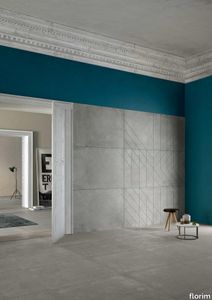
florim > Wallcovering
An atlas of modular signs to be combined in a wide variety of layouts. «We love concrete as a material, its versatility and its plain, austere look. We have completed our carefully designed surfaces with graphic patterning inspired by the human actions of weaving and embroidering.» Barbara Brondi & Marco Rainò To appreciate the profundity of the design project undertaken by Barbara Brondi and Marco Rainò for Cedit, it is both necessary and explanatory to start from the title the collection bears. In modern usage the term Matrice, in Italian, refers to a die or mould used to reproduce an object, but its origins are much more remote, with a meaning closer to the English “matrix”, meaning the underlying basis of something. The root of the word is related to Mater or mother: the name Matrice thus relates to the origin or cause of something. This dichotomy is expressed in several levels within the work of these architects, who study the world from a sophisticated conceptual approach and then transform it into a design. Starting from the idea of ceramic coverings, which have always been a tool not so much of architecture as of interior design, the artists work back to the origin of the surface and its decoration within their own discipline: they look at what we used to call the modern age, where modernity has also brought an uncompromising brutality, and where the use of bare concrete became the statement of an attitude to life with no time to spare for manners. Concrete is originally a liquid material, intended for shaping, which can therefore absorb and retain any type of mark created by the material and mould used to form it. Architects midway between rationalism and brutalism have used the rough-and-ready language of concrete combined with a last, elegant, anthropic decorative motif impressed on the material, that makes the concept of covering superfluous, because its place, in its older meaning of decoration rather than functional cladding, is taken by the regular patterning created in the material itself. There are therefore various grounds for believing that, in this collection, the artists are once again working in architectural terms. Firstly, with a simplicity typical of BRH+, they reduce the initial concepts to their minimal terms. So although this is a collection of coverings for walls, indoor floors, outdoor pavings and curtain walls, a great deal of time was spent on destructuring the idea of the ceramic covering itself. Unfortunately, nowadays there is no space in the contemporary construction sector for the radical approach of the past, so the cladding designed for the building actually lays bare the interior, using the choice of material – accurately interpreted (with shade variation) on the basis of an assortment of various types – to restore visual elegance and a fundamental severity. Attention to scale is another architectural feature: Matrice offers modules with architectural dimensions and different sizes through the development of “large slabs”, eliminating the visual regular grid effect. Thanks to this visual reset, geographic forms are perceived to emerge from dense, grey concrete surfaces decorated as in bygone days by special processes and by weathering during drying. The various types of slab, each an atlas of subtle, vibrant signs on the surfaces, comprise finishes that reproduce the visual effect of reinforced concrete – with the aggregates in the cement more clearly visible, of formwork – with the signs impressed on the concrete by the timber used, of a structured surface resembling bare cement plaster, of ridged and streaked surfaces – with patterning resembling some kinds of linear surface finishing processes – and finally a smooth, or basic version, over which Matrice exercises the dichotomy referred to earlier. It is on these surfaces that Brondi and Rainò have imagined additional design reverberations, a figurative code that rejects the concept of the grid, previously inseparable from that of the module: by means of a vocabulary of graphic marks cut into the slabs with a depth of 3 mm (the width of the gap left between modules during installation), they provide a framework for infinite combinations of possible dialogues. Just as in embroidery, which is based on grids of stitches and geometric repetitions, and where every stitch is at right-angles to another one to construct forms and decorations. Also taken from embroidery is the idea of introducing a degree of “softness” to reduce the stiffness of intentionally deaf surfaces. There is the impression of patterns that can continue for infinity, as in textile weaving, and a scale that, unlike the surface being worked on, is imagined as suspended and lightweight. They may not admit it, but BRH+ know a lot about music, including electronic music, and it appears to me that this organised tangle of infinite signs – unidentifiable without an overview – is rather like the representations of synthesized sounds. Sounds that are produced by machines, and thus “woven” by sampling and overlapping sounds of the most unlikely origins, combined to form jingles which, once heard, are imprinted indelibly on the brain. This may be why I am so interested in the space between this “melodic film” and its deaf, damp substrate. The eyes can navigate this suspended reality without fear of disturbance. So we are faced with different surfaces, different sizes and different graphic signs. But only one colour (surprise!) to prevent a cacophony not just of signs but also of possible interpretations: the artists retain their radical principles (and their generosity), and as curators, a role in which they are skilled, they leave the players (architects and installers) to add their own interpretations. In their hands this colour, expressed in Matrice, will produce motifs on surfaces in living spaces for someone else. This stylish covering and its workmanship will be left to the hands of someone who will probably never read this, but will be on a building site, with the radio playing on a stereo system, concentrating on installing the very pieces we describe. So a radical, apparently silent, design project like this has repercussions for the real world we live in. Matrice has no form of its own but merely acquires the ornamentation drawn on its surfaces by a second group of artists. And here this routine action, standardised by the form approved for production and workmanlike efficiency, is the origin and cause of change, generating a variability of choices and interpretations, on that dusty building site where music plays and mortar flows.
Globe-S Wox
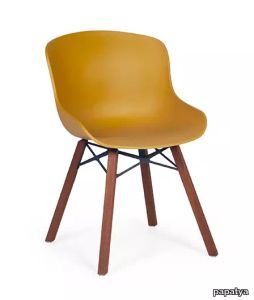
papatya > Chair
Spectacular characteristic design involves variety of solutions for home, work and hospitality settings. Its curved shape makes the design more attractive as a complement of trendy architectures. Globe Collection is inspired by our planet. Suitable for outdoor usage.
Hera-K Soft

papatya > Chair
Hera armchair with base in glassfibre reinforced polypropylene and the back in polycarbonate. This traditional armchair turns into a contemporary looking chair with combination of the two material and with its fashionable colours make it easily adaptable to every dynamic design environments. Anti UV stabilized. Suitable for indoor and outdoor use. Hera-K also available with rich selection of cushion models. It enriches the chair and gives a distinct character for the interior usages.
Matrice Aura

florim > Wallcovering
An atlas of modular signs to be combined in a wide variety of layouts. «We love concrete as a material, its versatility and its plain, austere look. We have completed our carefully designed surfaces with graphic patterning inspired by the human actions of weaving and embroidering.» Barbara Brondi & Marco Rainò To appreciate the profundity of the design project undertaken by Barbara Brondi and Marco Rainò for Cedit, it is both necessary and explanatory to start from the title the collection bears. In modern usage the term Matrice, in Italian, refers to a die or mould used to reproduce an object, but its origins are much more remote, with a meaning closer to the English “matrix”, meaning the underlying basis of something. The root of the word is related to Mater or mother: the name Matrice thus relates to the origin or cause of something. This dichotomy is expressed in several levels within the work of these architects, who study the world from a sophisticated conceptual approach and then transform it into a design. Starting from the idea of ceramic coverings, which have always been a tool not so much of architecture as of interior design, the artists work back to the origin of the surface and its decoration within their own discipline: they look at what we used to call the modern age, where modernity has also brought an uncompromising brutality, and where the use of bare concrete became the statement of an attitude to life with no time to spare for manners. Concrete is originally a liquid material, intended for shaping, which can therefore absorb and retain any type of mark created by the material and mould used to form it. Architects midway between rationalism and brutalism have used the rough-and-ready language of concrete combined with a last, elegant, anthropic decorative motif impressed on the material, that makes the concept of covering superfluous, because its place, in its older meaning of decoration rather than functional cladding, is taken by the regular patterning created in the material itself. There are therefore various grounds for believing that, in this collection, the artists are once again working in architectural terms. Firstly, with a simplicity typical of BRH+, they reduce the initial concepts to their minimal terms. So although this is a collection of coverings for walls, indoor floors, outdoor pavings and curtain walls, a great deal of time was spent on destructuring the idea of the ceramic covering itself. Unfortunately, nowadays there is no space in the contemporary construction sector for the radical approach of the past, so the cladding designed for the building actually lays bare the interior, using the choice of material – accurately interpreted (with shade variation) on the basis of an assortment of various types – to restore visual elegance and a fundamental severity. Attention to scale is another architectural feature: Matrice offers modules with architectural dimensions and different sizes through the development of “large slabs”, eliminating the visual regular grid effect. Thanks to this visual reset, geographic forms are perceived to emerge from dense, grey concrete surfaces decorated as in bygone days by special processes and by weathering during drying. The various types of slab, each an atlas of subtle, vibrant signs on the surfaces, comprise finishes that reproduce the visual effect of reinforced concrete – with the aggregates in the cement more clearly visible, of formwork – with the signs impressed on the concrete by the timber used, of a structured surface resembling bare cement plaster, of ridged and streaked surfaces – with patterning resembling some kinds of linear surface finishing processes – and finally a smooth, or basic version, over which Matrice exercises the dichotomy referred to earlier. It is on these surfaces that Brondi and Rainò have imagined additional design reverberations, a figurative code that rejects the concept of the grid, previously inseparable from that of the module: by means of a vocabulary of graphic marks cut into the slabs with a depth of 3 mm (the width of the gap left between modules during installation), they provide a framework for infinite combinations of possible dialogues. Just as in embroidery, which is based on grids of stitches and geometric repetitions, and where every stitch is at right-angles to another one to construct forms and decorations. Also taken from embroidery is the idea of introducing a degree of “softness” to reduce the stiffness of intentionally deaf surfaces. There is the impression of patterns that can continue for infinity, as in textile weaving, and a scale that, unlike the surface being worked on, is imagined as suspended and lightweight. They may not admit it, but BRH+ know a lot about music, including electronic music, and it appears to me that this organised tangle of infinite signs – unidentifiable without an overview – is rather like the representations of synthesized sounds. Sounds that are produced by machines, and thus “woven” by sampling and overlapping sounds of the most unlikely origins, combined to form jingles which, once heard, are imprinted indelibly on the brain. This may be why I am so interested in the space between this “melodic film” and its deaf, damp substrate. The eyes can navigate this suspended reality without fear of disturbance. So we are faced with different surfaces, different sizes and different graphic signs. But only one colour (surprise!) to prevent a cacophony not just of signs but also of possible interpretations: the artists retain their radical principles (and their generosity), and as curators, a role in which they are skilled, they leave the players (architects and installers) to add their own interpretations. In their hands this colour, expressed in Matrice, will produce motifs on surfaces in living spaces for someone else. This stylish covering and its workmanship will be left to the hands of someone who will probably never read this, but will be on a building site, with the radio playing on a stereo system, concentrating on installing the very pieces we describe. So a radical, apparently silent, design project like this has repercussions for the real world we live in. Matrice has no form of its own but merely acquires the ornamentation drawn on its surfaces by a second group of artists. And here this routine action, standardised by the form approved for production and workmanlike efficiency, is the origin and cause of change, generating a variability of choices and interpretations, on that dusty building site where music plays and mortar flows.
Opal-ML Pro
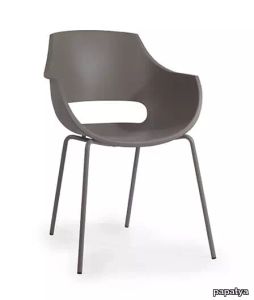
papatya > Chair
Opal-ML Pro armchair, a new member of Opal range ! Natural, warm, contemporary. The organic softness of the glassfibre polypropylene shell in mat colours offers a new way of looking and feeling. It’s a pleasant range where you can relax in perfect harmony. Available in all version of the frames from Opal Collection. Anti UV stabilized. Designed with public spaces in mind and suitable both for home and contract usages.
Slim Stripe
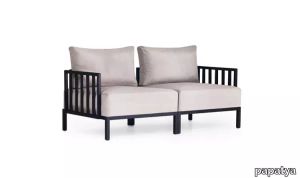
papatya > Sofa
Create your sofa set! Slim Sofa Set can be produced in limitless variety of configurations, it’s easy to place it by different combinations depending on space thanks to the modular system, can organize as 2 seater or 3 seater sofa or corner sofa set by linking modules. Slim Sofa has robust metal base and chic fabric options for indoor and outdoor usages.
Globe-K Swivel Soft
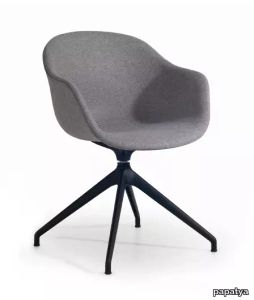
papatya > Chair
Spectacular characteristic design involves variety of solutions for home, work and hospitality settings. Its curved shape makes the design more attractive as a complement of trendy architectures. Globe Collection is inspired by our planet. Suitable for outdoor usage.
O'pera-S
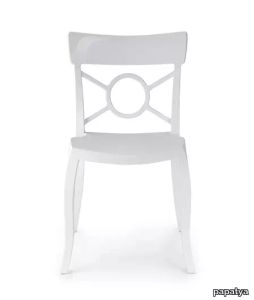
papatya > Chair
O'pera stackable chair with base in glassfibre reinforced polypropylene and the back in polycarbonate. This traditional chair turns into a contemporary looking chair with combination of the two material and with its fashionable colours make it easily adaptable to every dynamic design environments. Anti UV stabilized. Suitable for indoor and outdoor use. O'pera-S also available with rich selection of cushion models. It enriches the chair and gives a distinct character for the interior usages.
Globe-S ML
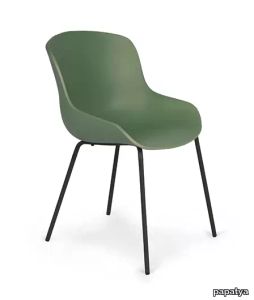
papatya > Chair
Spectacular characteristic design involves variety of solutions for home, work and hospitality settings. Its curved shape makes the design more attractive as a complement of trendy architectures. Globe Collection is inspired by our planet. Suitable for outdoor usage.
Globe-S Bar
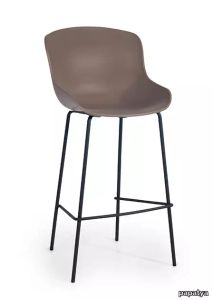
papatya > Stool
Spectacular characteristic design involves variety of solutions for home, work and hospitality settings. Its curved shape makes the design more attractive as a complement of trendy architectures. Globe Collection is inspired by our planet. Suitable for outdoor usage.
Luna

papatya > Chair
Luna armchair, stackable armchair with base in glassfibre reinforced polypropylene and the back in polycarbonate. Combination of the two material and fashionable colours makes it a perfect formula which adapts to every functional and aesthetic needs. Anti UV stabilized. Suitable for indoor and outdoor use. Luna is also available in removable upholstered seat version. It enriches the chair and gives a distinct character for the interior usages.
Luna Stripe
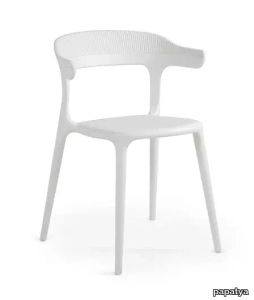
papatya > Chair
Luna Stripe armchair, stackable armchair with glassfibre reinforced polypropylene .Anti UV stabilized. Suitable for indoor and outdoor use. Luna is also available in removable upholstered seat version. It enriches the chair and gives a distinct character for the interior usages.
Opal Sled Pro
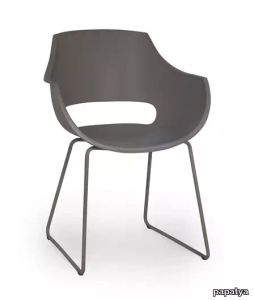
papatya > Chair
Opal Sled Pro armchair, a new member of Opal range ! Natural, warm, contemporary. The organic softness of the glassfibre polypropylene shell in mat colours offers a new way of looking and feeling. It’s a pleasant range where you can relax in perfect harmony. Available in all version of the frames from Opal Collection. Anti UV stabilized. Designed with public spaces in mind and suitable both for home and contract usages.
Globe-S Swivel
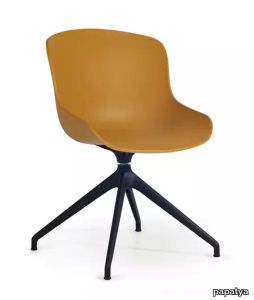
papatya > Chair
Spectacular characteristic design involves variety of solutions for home, work and hospitality settings. Its curved shape makes the design more attractive as a complement of trendy architectures. Globe Collection is inspired by our planet. Suitable for outdoor usage.
O'pera-K Soft
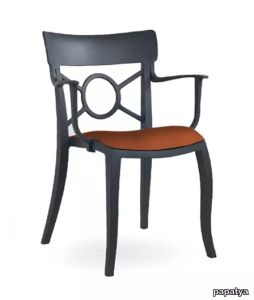
papatya > Chair
O'pera armchair with base in glassfibre reinforced polypropylene and the back in polycarbonate. This traditional chair turns into a contemporary looking chair with combination of the two material and with its fashionable colours make it easily adaptable to every dynamic design environments. Anti UV stabilized. Suitable for indoor and outdoor use. O'pera-K also available with rich selection of cushion models. It enriches the chair and gives a distinct character for the interior usages.
Globe-K Chief
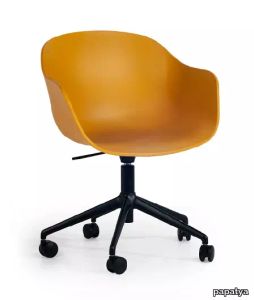
papatya > Chair
Spectacular characteristic design involves variety of solutions for home, work and hospitality settings. Its curved shape makes the design more attractive as a complement of trendy architectures. Globe Collection is inspired by our planet. Suitable for outdoor usage.
Globe-K Sled
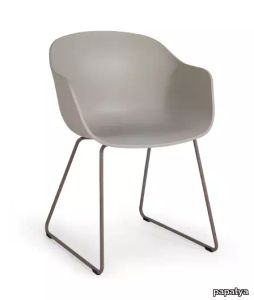
papatya > Chair
Spectacular characteristic design involves variety of solutions for home, work and hospitality settings. Its curved shape makes the design more attractive as a complement of trendy architectures. Globe Collection is inspired by our planet. Suitable for outdoor usage.
Globe-K Wox Soft
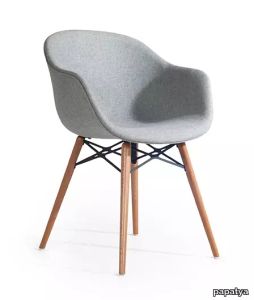
papatya > Chair
Spectacular characteristic design involves variety of solutions for home, work and hospitality settings. Its curved shape makes the design more attractive as a complement of trendy architectures. Globe Collection is inspired by our planet. Suitable for outdoor usage.
Matrice Essenza

florim > Wallcovering
An atlas of modular signs to be combined in a wide variety of layouts. «We love concrete as a material, its versatility and its plain, austere look. We have completed our carefully designed surfaces with graphic patterning inspired by the human actions of weaving and embroidering.» Barbara Brondi & Marco Rainò To appreciate the profundity of the design project undertaken by Barbara Brondi and Marco Rainò for Cedit, it is both necessary and explanatory to start from the title the collection bears. In modern usage the term Matrice, in Italian, refers to a die or mould used to reproduce an object, but its origins are much more remote, with a meaning closer to the English “matrix”, meaning the underlying basis of something. The root of the word is related to Mater or mother: the name Matrice thus relates to the origin or cause of something. This dichotomy is expressed in several levels within the work of these architects, who study the world from a sophisticated conceptual approach and then transform it into a design. Starting from the idea of ceramic coverings, which have always been a tool not so much of architecture as of interior design, the artists work back to the origin of the surface and its decoration within their own discipline: they look at what we used to call the modern age, where modernity has also brought an uncompromising brutality, and where the use of bare concrete became the statement of an attitude to life with no time to spare for manners. Concrete is originally a liquid material, intended for shaping, which can therefore absorb and retain any type of mark created by the material and mould used to form it. Architects midway between rationalism and brutalism have used the rough-and-ready language of concrete combined with a last, elegant, anthropic decorative motif impressed on the material, that makes the concept of covering superfluous, because its place, in its older meaning of decoration rather than functional cladding, is taken by the regular patterning created in the material itself. There are therefore various grounds for believing that, in this collection, the artists are once again working in architectural terms. Firstly, with a simplicity typical of BRH+, they reduce the initial concepts to their minimal terms. So although this is a collection of coverings for walls, indoor floors, outdoor pavings and curtain walls, a great deal of time was spent on destructuring the idea of the ceramic covering itself. Unfortunately, nowadays there is no space in the contemporary construction sector for the radical approach of the past, so the cladding designed for the building actually lays bare the interior, using the choice of material – accurately interpreted (with shade variation) on the basis of an assortment of various types – to restore visual elegance and a fundamental severity. Attention to scale is another architectural feature: Matrice offers modules with architectural dimensions and different sizes through the development of “large slabs”, eliminating the visual regular grid effect. Thanks to this visual reset, geographic forms are perceived to emerge from dense, grey concrete surfaces decorated as in bygone days by special processes and by weathering during drying. The various types of slab, each an atlas of subtle, vibrant signs on the surfaces, comprise finishes that reproduce the visual effect of reinforced concrete – with the aggregates in the cement more clearly visible, of formwork – with the signs impressed on the concrete by the timber used, of a structured surface resembling bare cement plaster, of ridged and streaked surfaces – with patterning resembling some kinds of linear surface finishing processes – and finally a smooth, or basic version, over which Matrice exercises the dichotomy referred to earlier. It is on these surfaces that Brondi and Rainò have imagined additional design reverberations, a figurative code that rejects the concept of the grid, previously inseparable from that of the module: by means of a vocabulary of graphic marks cut into the slabs with a depth of 3 mm (the width of the gap left between modules during installation), they provide a framework for infinite combinations of possible dialogues. Just as in embroidery, which is based on grids of stitches and geometric repetitions, and where every stitch is at right-angles to another one to construct forms and decorations. Also taken from embroidery is the idea of introducing a degree of “softness” to reduce the stiffness of intentionally deaf surfaces. There is the impression of patterns that can continue for infinity, as in textile weaving, and a scale that, unlike the surface being worked on, is imagined as suspended and lightweight. They may not admit it, but BRH+ know a lot about music, including electronic music, and it appears to me that this organised tangle of infinite signs – unidentifiable without an overview – is rather like the representations of synthesized sounds. Sounds that are produced by machines, and thus “woven” by sampling and overlapping sounds of the most unlikely origins, combined to form jingles which, once heard, are imprinted indelibly on the brain. This may be why I am so interested in the space between this “melodic film” and its deaf, damp substrate. The eyes can navigate this suspended reality without fear of disturbance. So we are faced with different surfaces, different sizes and different graphic signs. But only one colour (surprise!) to prevent a cacophony not just of signs but also of possible interpretations: the artists retain their radical principles (and their generosity), and as curators, a role in which they are skilled, they leave the players (architects and installers) to add their own interpretations. In their hands this colour, expressed in Matrice, will produce motifs on surfaces in living spaces for someone else. This stylish covering and its workmanship will be left to the hands of someone who will probably never read this, but will be on a building site, with the radio playing on a stereo system, concentrating on installing the very pieces we describe. So a radical, apparently silent, design project like this has repercussions for the real world we live in. Matrice has no form of its own but merely acquires the ornamentation drawn on its surfaces by a second group of artists. And here this routine action, standardised by the form approved for production and workmanlike efficiency, is the origin and cause of change, generating a variability of choices and interpretations, on that dusty building site where music plays and mortar flows.
Matrice Struttura

florim > Wallcovering
An atlas of modular signs to be combined in a wide variety of layouts. «We love concrete as a material, its versatility and its plain, austere look. We have completed our carefully designed surfaces with graphic patterning inspired by the human actions of weaving and embroidering.» Barbara Brondi & Marco Rainò To appreciate the profundity of the design project undertaken by Barbara Brondi and Marco Rainò for Cedit, it is both necessary and explanatory to start from the title the collection bears. In modern usage the term Matrice, in Italian, refers to a die or mould used to reproduce an object, but its origins are much more remote, with a meaning closer to the English “matrix”, meaning the underlying basis of something. The root of the word is related to Mater or mother: the name Matrice thus relates to the origin or cause of something. This dichotomy is expressed in several levels within the work of these architects, who study the world from a sophisticated conceptual approach and then transform it into a design. Starting from the idea of ceramic coverings, which have always been a tool not so much of architecture as of interior design, the artists work back to the origin of the surface and its decoration within their own discipline: they look at what we used to call the modern age, where modernity has also brought an uncompromising brutality, and where the use of bare concrete became the statement of an attitude to life with no time to spare for manners. Concrete is originally a liquid material, intended for shaping, which can therefore absorb and retain any type of mark created by the material and mould used to form it. Architects midway between rationalism and brutalism have used the rough-and-ready language of concrete combined with a last, elegant, anthropic decorative motif impressed on the material, that makes the concept of covering superfluous, because its place, in its older meaning of decoration rather than functional cladding, is taken by the regular patterning created in the material itself. There are therefore various grounds for believing that, in this collection, the artists are once again working in architectural terms. Firstly, with a simplicity typical of BRH+, they reduce the initial concepts to their minimal terms. So although this is a collection of coverings for walls, indoor floors, outdoor pavings and curtain walls, a great deal of time was spent on destructuring the idea of the ceramic covering itself. Unfortunately, nowadays there is no space in the contemporary construction sector for the radical approach of the past, so the cladding designed for the building actually lays bare the interior, using the choice of material – accurately interpreted (with shade variation) on the basis of an assortment of various types – to restore visual elegance and a fundamental severity. Attention to scale is another architectural feature: Matrice offers modules with architectural dimensions and different sizes through the development of “large slabs”, eliminating the visual regular grid effect. Thanks to this visual reset, geographic forms are perceived to emerge from dense, grey concrete surfaces decorated as in bygone days by special processes and by weathering during drying. The various types of slab, each an atlas of subtle, vibrant signs on the surfaces, comprise finishes that reproduce the visual effect of reinforced concrete – with the aggregates in the cement more clearly visible, of formwork – with the signs impressed on the concrete by the timber used, of a structured surface resembling bare cement plaster, of ridged and streaked surfaces – with patterning resembling some kinds of linear surface finishing processes – and finally a smooth, or basic version, over which Matrice exercises the dichotomy referred to earlier. It is on these surfaces that Brondi and Rainò have imagined additional design reverberations, a figurative code that rejects the concept of the grid, previously inseparable from that of the module: by means of a vocabulary of graphic marks cut into the slabs with a depth of 3 mm (the width of the gap left between modules during installation), they provide a framework for infinite combinations of possible dialogues. Just as in embroidery, which is based on grids of stitches and geometric repetitions, and where every stitch is at right-angles to another one to construct forms and decorations. Also taken from embroidery is the idea of introducing a degree of “softness” to reduce the stiffness of intentionally deaf surfaces. There is the impression of patterns that can continue for infinity, as in textile weaving, and a scale that, unlike the surface being worked on, is imagined as suspended and lightweight. They may not admit it, but BRH+ know a lot about music, including electronic music, and it appears to me that this organised tangle of infinite signs – unidentifiable without an overview – is rather like the representations of synthesized sounds. Sounds that are produced by machines, and thus “woven” by sampling and overlapping sounds of the most unlikely origins, combined to form jingles which, once heard, are imprinted indelibly on the brain. This may be why I am so interested in the space between this “melodic film” and its deaf, damp substrate. The eyes can navigate this suspended reality without fear of disturbance. So we are faced with different surfaces, different sizes and different graphic signs. But only one colour (surprise!) to prevent a cacophony not just of signs but also of possible interpretations: the artists retain their radical principles (and their generosity), and as curators, a role in which they are skilled, they leave the players (architects and installers) to add their own interpretations. In their hands this colour, expressed in Matrice, will produce motifs on surfaces in living spaces for someone else. This stylish covering and its workmanship will be left to the hands of someone who will probably never read this, but will be on a building site, with the radio playing on a stereo system, concentrating on installing the very pieces we describe. So a radical, apparently silent, design project like this has repercussions for the real world we live in. Matrice has no form of its own but merely acquires the ornamentation drawn on its surfaces by a second group of artists. And here this routine action, standardised by the form approved for production and workmanlike efficiency, is the origin and cause of change, generating a variability of choices and interpretations, on that dusty building site where music plays and mortar flows.
X-treme S Pro

papatya > Chair
X-treme S pro chair, a new member of X-Treme range ! Natural, warm, contemporary. The organic softness of the glassfibre polypropylene shell in mat colours offers a new way of looking and feeling. It’s a pleasant range where you can relax in perfect harmony. Available in all version of the frames from X-Treme Collection. Anti UV stabilized. Designed with public spaces in mind and suitable both for home and contract usages.
Globe-S Wox
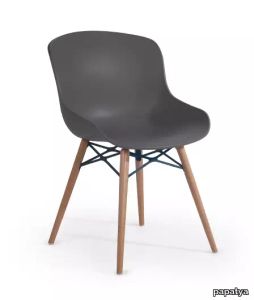
papatya > Chair
Spectacular characteristic design involves variety of solutions for home, work and hospitality settings. Its curved shape makes the design more attractive as a complement of trendy architectures. Globe Collection is inspired by our planet. Suitable for outdoor usage.
X-Treme Sled Pro
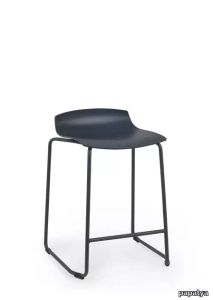
papatya > Stool
A new member of X-Treme range ! Natural, warm, contemporary. The organic softness of the glassfibre polypropylene shell in mat colours offers a new way of looking and feeling. It’s a pleasant range where you can relax in perfect harmony. Available in all version of the frames from X-Treme Collection. Anti UV stabilized. Designed with public spaces in mind and suitable both for home and contract usages.
Globe-K Wox
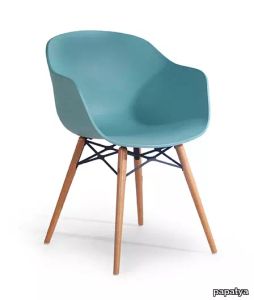
papatya > Chair
Spectacular characteristic design involves variety of solutions for home, work and hospitality settings. Its curved shape makes the design more attractive as a complement of trendy architectures. Globe Collection is inspired by our planet. Suitable for outdoor usage.
Slim Stripe
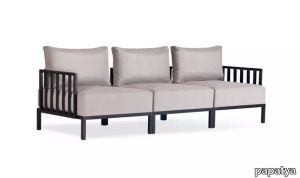
papatya > Sofa
Create your sofa set! Slim Sofa Set can be produced in limitless variety of configurations, it’s easy to place it by different combinations depending on space thanks to the modular system, can organize as 2 seater or 3 seater sofa or corner sofa set by linking modules. Slim Sofa has robust metal base and chic fabric options for indoor and outdoor usages.
Yugo-S Wox Soft
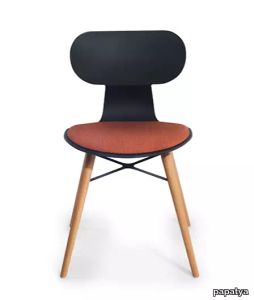
papatya > Chair
Yugo-S Wox chair, with its curvaceous form, the YUGO-S WOX chair is comfortable and elegant. Chair shell in glassfibre rainforced polypropylene and frame in natural beech wood complements any décor, adding distinction, strength and charm, and making the statement of individuality. Perfect for home and for contract usage.
X-treme BSL Wox Pro
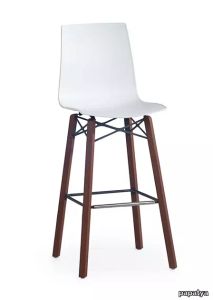
papatya > Stool
X-treme S Wox Pro chair, a new member of X-Treme range ! Natural, warm, contemporary. The organic softness of the glassfibre polypropylene shell in mat colours offers a new way of looking and feeling. It’s a pleasant range where you can relax in perfect harmony. Available in all version of the frames from X-Treme Collection. Offers warm combinations especially in wood frame X-Treme WOX range. Anti UV stabilized. Designed with public spaces in mind and suitable both for home and contract usages.
Hera-S
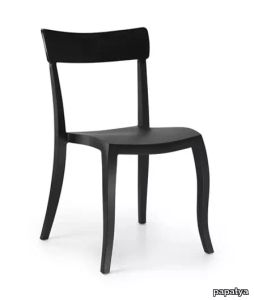
papatya > Chair
Hera chair, stackable armchair with base in glassfibre reinforced polypropylene and the back in polycarbonate. This traditional armchair turns into a contemporary looking chair with combination of the two material and with its fashionable colours make it easily adaptable to every dynamic design environments. Anti UV stabilized. Suitable for indoor and outdoor use. Hera-K also available with rich selection of cushion models. It enriches the chair and gives a distinct character for the interior usages.
Globe-S Chief Soft
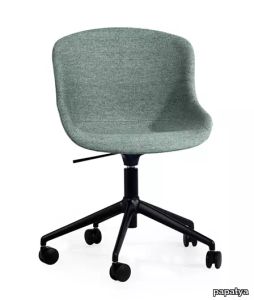
papatya > Chair
Spectacular characteristic design involves variety of solutions for home, work and hospitality settings. Its curved shape makes the design more attractive as a complement of trendy architectures. Globe Collection is inspired by our planet. Suitable for outdoor usage.
X-treme S Sled Pro

papatya > Chair
The organic softness of the glassfibre polypropylene shell in mat colours offers a new way of looking and feeling. It’s a pleasant range where you can relax in perfect harmony. Anti UV stabilized. Designed with public spaces in mind and suitable both for home and contract usages.
X-treme S Pro
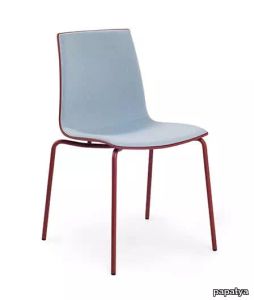
papatya > Chair
X-treme S Pro Soft chair, a new member of X-Treme range ! More natural, warm and contemporary. Polypropylene shell with fix cushion offers a new way of looking and feeling. It’s a pleasant range where you can relax in perfect harmony. Available in all version of the frames from X-Treme Collection. Designed with public spaces in mind and suitable both for home and contract usages.
Globe-K ML
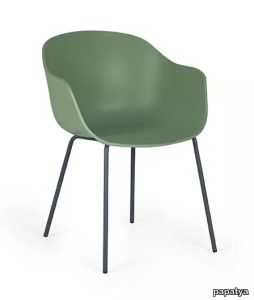
papatya > Chair
Spectacular characteristic design involves variety of solutions for home, work and hospitality settings. Its curved shape makes the design more attractive as a complement of trendy architectures. Globe Collection is inspired by our planet. Suitable for outdoor usage.
Globe-K ML Soft
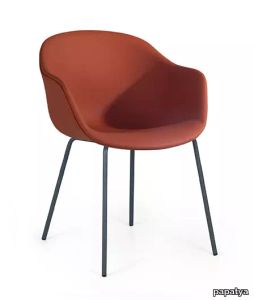
papatya > Chair
Spectacular characteristic design involves variety of solutions for home, work and hospitality settings. Its curved shape makes the design more attractive as a complement of trendy architectures. Globe Collection is inspired by our planet. Suitable for outdoor usage.
X-treme S Wox Pro
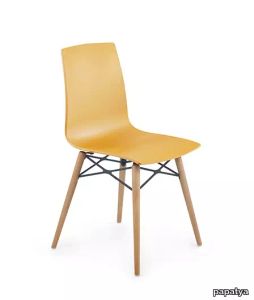
papatya > Chair
X-treme S Wox Pro chair, a new member of X-Treme range ! Natural, warm,contemporary. The organic softness of the glassfibre polypropylene shell in mat colours offers a new way of looking and feeling. It’s a pleasant range where you can relax in perfect harmony. Available in all version of the frames from X-Treme Collection. Offers warm combinations especially in wood frame X-Treme WOX range. Anti UV stabilized. Designed with public spaces in mind and suitable both for home and contract usages.
X-treme S Sled Pro

papatya > Chair
Natural, warm and contemporary. Polypropylene shell with fix cushion offers a new way of looking and feeling. It’s a pleasant range where you can relax in perfect harmony. Available in all version of the frames from X-Treme Collection. Designed with public spaces in mind and suitable both for home and contract usages.
X-Treme BSL Pro
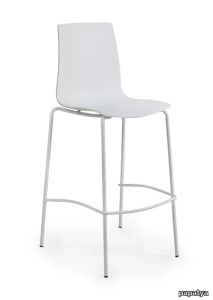
papatya > Stool
A new member of X-Treme range ! Natural, warm, contemporary. The organic softness of the glassfibre polypropylene shell in mat colours offers a new way of looking and feeling. It’s a pleasant range where you can relax in perfect harmony. Available in all version of the frames from X-Treme Collection. Anti UV stabilized. Designed with public spaces in mind and suitable both for home and contract usages.
Globe-S Swivel Soft
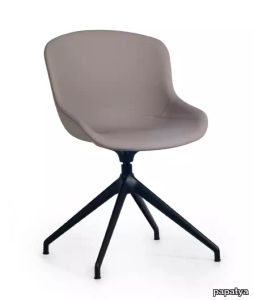
papatya > Chair
Spectacular characteristic design involves variety of solutions for home, work and hospitality settings. Its curved shape makes the design more attractive as a complement of trendy architectures. Globe Collection is inspired by our planet. Suitable for outdoor usage.
Globe-S ML Soft
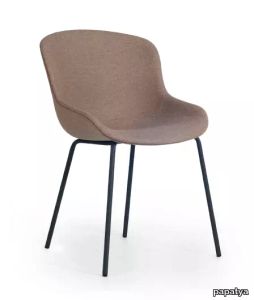
papatya > Chair
Spectacular characteristic design involves variety of solutions for home, work and hospitality settings. Its curved shape makes the design more attractive as a complement of trendy architectures. Globe Collection is inspired by our planet. Suitable for outdoor usage.
X-treme SD Wox
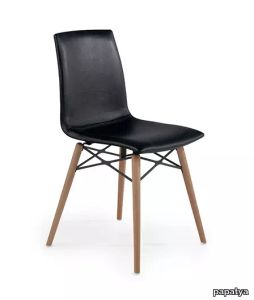
papatya > Chair
Soft chair, a new member of X-Treme range ! More natural, warm and contemporary. Polypropylene shell with fix cushion offers a new way of looking and feeling. It’s a pleasant range where you can relax in perfect harmony. Available in all version of the frames from X-Treme Collection. Designed with public spaces in mind and suitable both for home and contract usages.
Globe-S Wox Soft
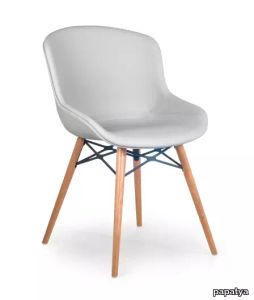
papatya > Chair
Spectacular characteristic design involves variety of solutions for home, work and hospitality settings. Its curved shape makes the design more attractive as a complement of trendy architectures. Globe Collection is inspired by our planet. Suitable for outdoor usage.
Opal Wox
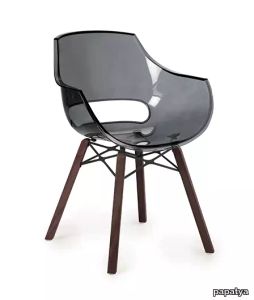
papatya > Chair
Opal Wox Pro armchair, a new member of Opal range ! Natural, warm, contemporary. The organic softness of the glassfibre polypropylene shell in mat colours offers a new way of looking and feeling. It’s a pleasant range where you can relax in perfect harmony. Available in all version of the frames from Opal Collection. Offers warm combinations especially in wood frame Opal WOX range. Anti UV stabilized. Designed with public spaces in mind and suitable both for home and contract usages.
Globe-K Swivel
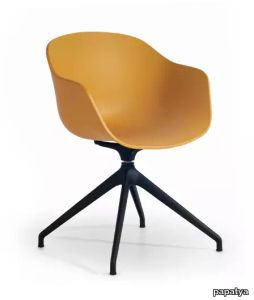
papatya > Chair
Spectacular characteristic design involves variety of solutions for home, work and hospitality settings. Its curved shape makes the design more attractive as a complement of trendy architectures. Globe Collection is inspired by our planet. Suitable for outdoor usage.
Slim Center Low Table
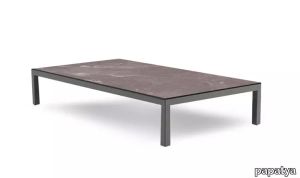
papatya > Sofa
Create your sofa set! Slim Sofa Set can be produced in limitless variety of configurations, it’s easy to place it by different combinations depending on space thanks to the modular system, can organize as 2 seater or 3 seater sofa or corner sofa set by linking modules. Slim Sofa has robust metal base and chic fabric options for indoor and outdoor usages.
X-treme BSS Wox Pro
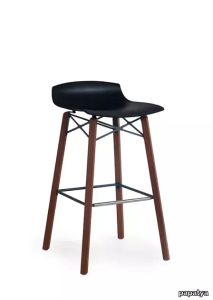
papatya > Stool
X-treme S Wox Pro chair, a new member of X-Treme range ! Natural, warm, contemporary. The organic softness of the glassfibre polypropylene shell in mat colours offers a new way of looking and feeling. It’s a pleasant range where you can relax in perfect harmony. Available in all version of the frames from X-Treme Collection. Offers warm combinations especially in wood frame X-Treme WOX range. Anti UV stabilized. Designed with public spaces in mind and suitable both for home and contract usages.
Opal-ML
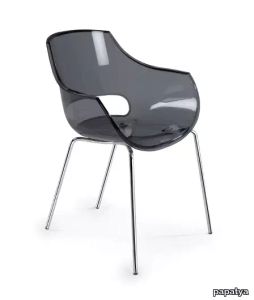
papatya > Chair
Opal-ML armchair, stackable stylish armchair exists in two types of expressive transparent and solid colour versions. Shell is made of polycarbonate with steel tube structure. Anti UV stabilized. Opal armchair is also available in fully upholstered shell version. It enriches the chair and gives a distinct character for the interior usages.
Globe-K Swivel Chief Soft
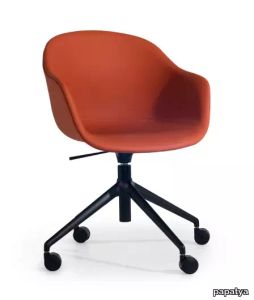
papatya > Chair
Spectacular characteristic design involves variety of solutions for home, work and hospitality settings. Its curved shape makes the design more attractive as a complement of trendy architectures. Globe Collection is inspired by our planet. Suitable for outdoor usage.
Globe-K Bar Soft
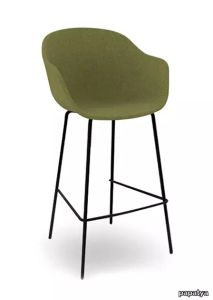
papatya > Stool
Spectacular characteristic design involves variety of solutions for home, work and hospitality settings. Its curved shape makes the design more attractive as a complement of trendy architectures. Globe Collection is inspired by our planet. Suitable for outdoor usage.
Opal Sled
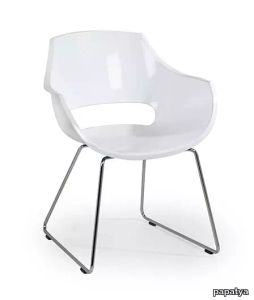
papatya > Chair
Opal Sled armchair, stackable stylish armchair exists in two types of expressive transparent and solid colour versions. Shell is made of polycarbonate with steel tube structure. Anti UV stabilized. Opal armchair is also available in fully upholstered shell version. It enriches the chair and gives a distinct character for the interior usages.
Yugo-S Wox
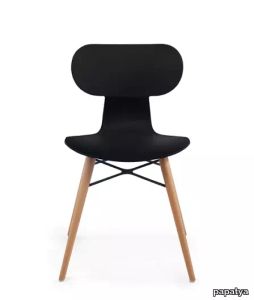
papatya > Chair
Yugo-S Wox chair, with its curvaceous form, the YUGO-S WOX chair is comfortable and elegant. Chair shell in glassfibre rainforced polypropylene and frame in natural beech wood complements any décor, adding distinction, strength and charm, and making the statement of individuality. Perfect for home and for contract usage.
Globe-S Sled
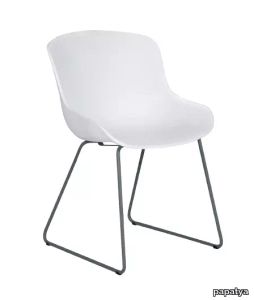
papatya > Chair
Spectacular characteristic design involves variety of solutions for home, work and hospitality settings. Its curved shape makes the design more attractive as a complement of trendy architectures. Globe Collection is inspired by our planet. Suitable for outdoor usage.